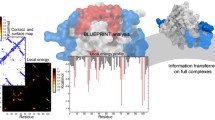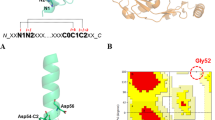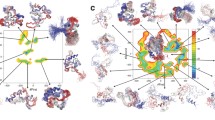Abstract
Charged amino acids are mostly exposed on a protein surface, thereby forming a network of interactions with the surrounding amino acids as well as with water. In particular, positively charged arginine and lysine have different side chain geometries and provide a different number of potential electrostatic interactions. This study reports a comparative analysis of the difference in the number of two representative electrostatic interactions, such as salt-bridges and hydrogen bonds, contributed by surface arginine and lysine, as well as their effect on protein stability using molecular modeling and dynamics simulation techniques. Two in silico variants, the R variant with all arginines and the K variant with all lysines on the protein surface, were modeled by mutating all the surface lysines to arginines and the surface arginines to lysines, respectively, for each of the 10 model proteins. A structural comparison of the respective two variants showed that the majority of R variants possessed more salt-bridges and hydrogen bond interactions than the K variants, indicating that arginine provides a higher probability of electrostatic interactions than lysine owing to its side chain geometry. Molecular dynamics simulations of these variants revealed the R variants to be more stable than the K variants at room temperature but this effect was not prominent under protein denaturating conditions, such as 353 and 333 K with 8 M urea. These results suggest that the arginine residues on a protein surface contribute to the protein stability slightly more than lysine by enhancing the electrostatic interactions.
Similar content being viewed by others
References
Strickler, S. S., A. V. Gribenko, A. V. Gribenko, T. R. Keiffer, J. Tomlinson, T. Reihle, V. V. Loladze, and G. I. Makhatadze (2006) Protein stability and surface electrostatics: A charged relationship. Biochem. 45: 2761–2766.
Baldwin, R. L. (2007) Energetics of protein folding. J. Mol. Biol. 371: 283–301.
Halskau, O., R. Perez-Jimenez, B. Ibarra-Molero, J. Underhaug, V. Munoz, A. Martinez, and J. M. Sanchez-Ruiz (2008) Large scale modulation of thermodynamic protein folding barriers linked to electrostatics. Proc. Natl. Acad. Sci. U. S. A. 105: 8625–8630.
Park, H., J. Joo, K. Park, and Y. Yoo (2012) Stabilization of Candida antarctica lipase B in hydrophilic organic solvent by rational design of hydrogen bond. Biotechnol. Bioproc. Eng. 17: 722–728.
Tissot, A. C., S. Vuilleumier, and A. R. Fersht (1996) Importance of two buried salt bridges in the stability and folding pathway of barnase. Biochem. 35: 6786–6794.
Pervushin, K., M. Billeter, G. Siegal, and K. Wüthrich (1996) Structural role of a buried salt bridge in the 434 repressor DNA-binding domain. J. Mol. Biol. 264: 1002–1012.
Akke, M. and S. Forsén (1990) Protein stability and electrostatic interactions between solvent exposed charged side chains. Proteins: Struct. Funct. Bioinform. 8: 23–29.
Permyakov, S. E., G. I. Makhatadze, R. Owenius, V. N. Uversky, C. L. Brooks, E. A. Permyakov, and L. J. Berliner (2005) How to improve nature: Study of the electrostatic properties of the surface of -lactalbumin. Protein Eng. Des. Sel. 18: 425–433.
Makhatadze, G. I., V. V. Loladze, A. V. Gribenko, and M. M. Lopez (2004) Mechanism of thermostabilization in a designed cold shock protein with optimized surface electrostatic interactions. J. Mol. Biol. 336: 929–942.
Flores, K., J. Salgado, G. Zapata-Torres, Z. Gerdtzen, M. -J. Gonzalez, and M. Hermoso (2012) Effect of the electrostatic potential on the internalization mechanism of cell penetrating peptides derived from TIRAP. Biotechnol. Bioproc. Eng. 17: 485–499.
Kumar, S., C. -J. Tsai, and R. Nussinov (2000) Factors enhancing protein thermostability. Protein Eng. 13: 179–191.
Yokota, K., K. Satou, and S. -Y. Ohki (2006) Comparative analysis of protein thermostability: Differences in amino acid content and substitution at the surfaces and in the core regions of thermophilic and mesophilic proteins. Sci. Tech. Adv. Mater. 7: 255–262.
Borders, C. L., J. A. Broadwater, P. A. Bekeny, J. E. Salmon, A. S. Lee, A. M. Eldridge, and V. B. Pett (1994) A structural role for arginine in proteins: Multiple hydrogen bonds to backbone carbonyl oxygens. Protein Sci. 3: 541–548.
Donald, J. E., D. W. Kulp, and W. F. DeGrado (2011) Salt bridges: Geometrically specific, designable interactions. Proteins: Struct. Funct. Bioinform. 79: 898–915.
Sokalingam, S., G. Raghunathan, N. Soundrarajan, and S. -G. Lee (2012) A study on the effect of surface lysine to arginine mutagenesis on protein stability and structure using green fluorescent protein. PLoS One. 7: 40410.
Strub, C., C. Alies, A. Lougarre, C. Ladurantie, J. Czaplicki, and D. Fournier (2004) Mutation of exposed hydrophobic amino acids to arginine to increase protein stability. BMC Biochem. 5: 9.
Zhou, X. X., Y. B. Wang, Y. J. Pan, and W. F. Li (2007) Differences in amino acids composition and coupling patterns between mesophilic and thermophilic proteins. Amino Acids. 34: 25–33.
Marti-Renom, M. A., A. C. Stuart, A. Fiser, R. Sanchez, F. Melo, and A. Sali (2000) Comparative protein structure modeling of genes and genomes. Annu. Rev. Biophys. Biomol. Struct. 29: 291–325.
Hess, B., C. Kutzner, D. van der Spoel, and E. Lindahl (2008) GROMACS 4: Algorithms for highly efficient, load-balanced, and scalable molecular simulation. J. Chem. Theory Comput. 4: 435–447.
Schuttelkopf, A. W. and D. M. F. van Aalten (2004) PRODRG: A tool for high-throughput crystallography of protein-ligand complexes. Acta Crystallogr. Sect. D. Biol. Crystallogr. 60: 1355–1363.
Murzin, A. G., S. E. Brenner, T. Hubbard, and C. Chothia (1995) SCOP: A structural classification of proteins database for the investigation of sequences and structures. J. Mol. Biol. 247: 536–540.
Bernstein, F. C., T. F. Koetzle, G. J. B. Williams, E. F. Meyer Jr, M. D. Brice, J. R. Rodgers, O. Kennard, T. Shimanouchi, and M. Tasumi (1978) The protein data bank: A computer-based archival file for macromolecular structures. Arch. Biochem. Biophys. 185: 584–591.
Rose, G. D., P. J. Fleming, J. R. Banavar, and A. Maritan (2006) A backbone-based theory of protein folding. Proc. Natl. Acad. Sci. U. S. A. 103: 16623–16633.
Daggett, V. and A. Fersht (2003) The present view of the mechanism of protein folding. Nat. Rev. Mol. Cell Biol. 4: 497–502.
Fromm, J. R., R. E. Hileman, E. E. O. Caldwell, J. M. Weiler, and R. J. Linhardt (1995) Differences in the interaction of heparin with arginine and lysine and the importance of these basic amino acids in the binding of heparin to acidic fibroblast growth factor. Arch. Biochem. Biophys. 323: 279–287.
Matsutani, M., H. Hirakawa, M. Nishikura, W. Soemphol, I. A. I. Ali, T. Yakushi, and K. Matsushita (2011) Increased number of arginine-based salt bridges contributes to the thermotolerance of thermotolerant acetic acid bacteria, Acetobacter tropicalis SKU1100. Biochem. Biophys. Res. Commun. 409: 120–124.
Kagawa, M., Z. Fujimoto, M. Momma, K. Takase, and H. Mizuno (2003) Crystal structure of Bacillus subtilis alpha-amylase in complex with acarbose. J. Bacteriol. 185: 6981–6984.
Lee, J. and M. Paetzel (2011) Structure of the catalytic domain of glucoamylase from Aspergillus niger. Acta Crystallogr. Sect. F Struct. Biol. Cryst. Commun. 67: 188–192.
Kohno, M., J. Funatsu, B. Mikami, W. Kugimiya, T. Matsuo, and Y. Morita (1996) The crystal structure of lipase II from Rhizopus niveus at 2.2 A resolution. J. Biochem. 120: 505–510.
Santos, C. R., J. H. Paiva, M. L. Sforca, J. L. Neves, R. Z. Navarro, J. Cota, P. K. Akao, Z. B. Hoffmam, A. N. Meza, J. H. Smetana, M. L. Nogueira, I. Polikarpov, J. Xavier-Neto, F. M. Squina, R. J. Ward, R. Ruller, A. C. Zeri, and M. T. Murakami (2012) Dissecting structure-function-stability relationships of a thermostable GH5-CBM3 cellulase from Bacillus subtilis 168. Biochem. J. 441: 95–104.
van Pouderoyen, G., H. J. Snijder, J. A. Benen, and B. W. Dijkstra (2003) Structural insights into the processivity of endopolygalacturonase I from Aspergillus niger. FEBS Lett. 554: 462–466.
Almog, O., A. Gonzalez, N. Godin, M. de Leeuw, M. J. Mekel, D. Klein, S. Braun, G. Shoham, and R. L. Walter (2009) The crystal structures of the psychrophilic subtilisin S41 and the mesophilic subtilisin Sph reveal the same calcium-loaded state. Proteins. 74: 489–496.
Wouters, J., J. Georis, D. Engher, J. Vandenhaute, J. Dusart, J. M. Frere, E. Depiereux, and P. Charlier (2001) Crystallographic analysis of family 11 endo-beta-1,4-xylanase Xyl1 from Streptomyces sp. S38. Acta Crystallogr. Sect. D. Biol. Crystallogr. 57: 1813–1819.
Schultz, L. W., L. Liu, M. Cegielski, and J. W. Hastings (2005) Crystal structure of a pH-regulated luciferase catalyzing the bioluminescent oxidation of an open tetrapyrrole. Proc. Natl. Acad. Sci. U. S. A. 102: 1378–1383.
Guillet, V., A. Lapthorn, R. W. Hartley, and Y. Mauguen (1993) Recognition between a bacterial ribonuclease, barnase, and its natural inhibitor, barstar. Structure. 1: 165–176.
Summerfield, R. L., D. M. Daigle, S. Mayer, D. Mallik, D. W. Hughes, S. G. Jackson, M. Sulek, M. G. Organ, E. D. Brown, and M. S. Junop (2006) A 2.13 A structure of E. coli dihydrofolate reductase bound to a novel competitive inhibitor reveals a new binding surface involving the M20 loop region. J. Med. Chem. 49: 6977–6986.
Author information
Authors and Affiliations
Corresponding author
Rights and permissions
About this article
Cite this article
Sokalingam, S., Madan, B., Raghunathan, G. et al. In silico study on the effect of surface lysines and arginines on the electrostatic interactions and protein stability. Biotechnol Bioproc E 18, 18–26 (2013). https://doi.org/10.1007/s12257-012-0516-1
Received:
Revised:
Accepted:
Published:
Issue Date:
DOI: https://doi.org/10.1007/s12257-012-0516-1




